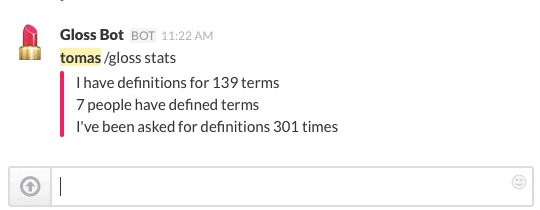This is a simple web app designed to be used as a Slack integration. Specifically, it responds to POSTs created by the Slack Slash Commands integration and responds with messages to Slack's Incoming Webhooks integration.
Glossary Bot maintains a glossary of terms created by its users, and responds to requests with definitions.
Glossary Bot is a Flask app built to run on Heroku.
To install locally, clone this repository and cd into the resulting directory:
git clone git@github.com:codeforamerica/glossary-bot.git
cd glossary-bot
Set up and activate a new virtual environment using Virtualenv:
virtualenv venv-glossary-bot
Activate the virtual environment:
source venv-glossary-bot/bin/activate
Install the required packages with pip:
pip install -r requirements.txt
Create the production PostgreSQL database:
createdb glossary-bot
Copy env.sample to .env and make sure that the value of DATABASE_URL in .env matches the name of the database you created in the last step:
cp env.sample .env
Initialize the database:
python manage.py createdb
And run the application:
python manage.py runserver
To run the app's tests, first create a test database. Make sure the name of the database matches the value of environ['DATABASE_URL'] set in the setUp() function in test/test_bot.py:
createdb glossary-bot-test
You can now run the tests from the command line:
python manage.py runtests
or run an individual test:
python tests/test_bot.py BotTestCase.test_get_definition
Glossary Bot uses two Slack integrations: Slash Commands for private communication between the bot and the user, and Incoming Webhooks for posting public messages.
Set up a Slash Command integration. There are three critical values that you need to set or save: Command is the command people on slack will use to communicate with the bot. We use /gloss. URL is the public URL where the bot will live; you can fill this in after you've deployed the application to Heroku, as described below. Token is used to authenticate communication between Slack and the bot; save this value for when you're setting up the bot on Heroku.
Set up an Incoming Webhooks integration. The two important values here are: Post to Channel, which is a default channel where public messages from the bot will appear. This default is always overridden by the bot, but you do need to have one – we created a new channel called #testing-glossary-bot for this purpose. Save the value of Webhook URL; this is the URL that the bot will POST public messages to, and you'll need it when setting up Gloss Bot on Heroku.
Now it's time to deploy the bot to Heroku! First, make sure you've got the basics set up by following Heroku's instructions for getting started with Python.
Now, create a new Heroku application with a unique name:
heroku create my-glossary-bot
When you deploy your app, it'll be reachable at a URL like https://my-glossary-bot.herokuapp.com/. Enter this URL into the URL field of the Slash Commands integration on Slack. See the Heroku documentation for more configuration options.
To give the bot everything it needs to communicate with Slack, set the config variables you saved when you set up the Slack integrations above. The Token from the Slash Command integration:
heroku config:set SLACK_TOKEN=1234567890
and the Webhook URL from the Incoming Webhooks integration:
heroku config:set SLACK_WEBHOOK_URL=https://hooks.slack.com/services/1234567/1234567/1234567890
You can also set these variables in the Heroku web interface.
Now run a git push to deploy the application:
git push heroku master
And you're good to get glossing!
